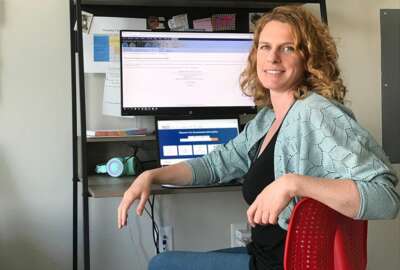The great telework era is over, partly because the benefits are uncertain
The Government Accountability Office (GAO) has been sifting through stacks of research on how many people actually teleworked over the last three years, and whether...
The Government Accountability Office (GAO) has been sifting through stacks of research on how many people actually teleworked over the last three years, and whether telework will continue to have a positive economic impact. For what auditors learned, Federal Drive with Tom Temin spoke John Sawyer, GAO’s director of Education, Workforce and Income Security.
Interview Transcript:
Tom Temin And tell us what you are looking at here. It looks like you did sort of a survey of the surveys that have been done.
John Sawyer Exactly. We were asked through a congressional request to look at the impact of telework on worker productivity and worker performance. And we also presented sort of a snapshot as to what telework was like prior to the pandemic, and telework after the pandemic.
Tom Temin And I think one of the most surprising findings is how low the percentage of people teleworking actually was, even though the streets were devoid of cars and people for a while.
John Sawyer Exactly. That is one thing that we did find. And I think some 90% of individuals still did not telework. While telework increased, there was still a great deal of individuals in our economy that did not telework. We found that a lot of that is driven because certain occupations, certain industries just do not lend itself to telework.
Tom Temin So for every Manhattan office building, there are probably ten chicken processing plants where people have to process chickens hands on.
John Sawyer Absolutely, because the nature of the job requires demands of physical presence to accomplish the goals and objective.
Tom Temin Yeah. So you really can’t walk down Sixth Avenue and get some sense of what the economy is really all about then. Can you?
John Sawyer Absolutely. There are factors to consider. There are other, as I said, industries and occupations that kept this economy going during one of the worst events that our country has experienced, and that is the pandemic.
Tom Temin And by the way, this particular survey of the literature did not include federal teleworking experience.
John Sawyer You are correct. We excluded that because the objectives that we were presented allowed us or required us to exclude public administration from our review. However, we do have work that we are currently designing that is looking at telework in the federal government. This review did not cover.
Tom Temin And getting back to the private sector then, what did you find in terms of the economic benefits or other benefits? And I guess, one of the findings you had is that in the future it’s all uncertain the effects of telework. So what was the general trend you found here?
John Sawyer I think to answer that is when you talk about the benefits of teleworking. The studies that we reviewed did show a slight increase in telework. But I also believe that what’s important to note, as we mentioned earlier, that based on your job, the occupation, the industry, telework may not lend itself so quickly or so easily for a certain industry. So I believe that a company or a firm or business, whoever is designing a future telework policy or the posture of telework in the future, you first have to know what your brand is, what are your objectives? What is it that you are accomplishing? What is it that you need to accomplish? And then you develop outcomes to measure whether or not telework is beneficial.
Tom Temin We’re speaking with John Sawyer. He is director of Education, Workforce and Income Security issues at the Government Accountability Office. And so I guess, it varies then by industry. Is there any one story that we can tell here as to whether telework is effective for industry in general or how widely does it vary?
John Sawyer Well, there were studies from our review, for instance, Tom, of call centers that if your objective is to answer phone calls and provide information, then the results show that productivity did increase some 13%. However, if you are working as a research scientist, if you’re developing research for the next product line, then it’s kind of harder to really ascertain whether or not telework was productive in that environment. So those are the type of things that we found in our review.
Tom Temin In other words, to the extent that you can even measure productivity has a big effect on whether you know the effects of telework. Call centers, calls completed, calls resolved, calls satisfaction. They measure every single millisecond of a telework call. Research science, how do you measure productivity, when ten years of research could, whoops, we were wrong. That’s a good outcome, but it’s kind of hard to measure productivity there.
John Sawyer Absolutely. And that is one of the things that we did note and encountered during review of the research available.
Tom Temin Other than call centers, did any other type of occupation stand out as something that was helped by telework or was more productive?
John Sawyer Again, what we found is that how you measure telework drives the results. For instance, subjective information, information that’s coming from individuals assessing their productivity. Teleworking showed that, yes, based on those survey results, individuals said that they were more productive at home. And that is one of the things we noted, that when you determine or when you identify the measures of measuring the impact of telework, you just have to be careful what you use because there are objective measurements and subjective measurements, and they give you different results.
Tom Temin Yes, Right. So self-reporting is going to be self-selecting. Of course, if I like telework, I guess there are few people that maybe prefer the office or actually there’s more than a few. They might feel that they’re more productive, although I’ve heard it really both ways. People that prefer the Office feel that even though they were equally productive, let’s say, they just prefer the office because of non tangible benefits. And probably maybe that’s the crux here, is that so much of telework qualities are really intangible.
John Sawyer Absolutely. One study mentioning that Tom brings to mind a study that found that employees were more likely to be more innovative during their brainstorming sessions. That was in the office place versus video conferencing or virtual. The study found that the innovations, the input was just not as great as it was inside the workplace.
Tom Temin Right. So there is an intangible effect of human interaction that results in a measurable change in output.
John Sawyer Absolutely. Which is one of the things that I believe that any entity or business that’s looking at the future of telework, you have to consider such things as this. What is the impact on collaboration? What is the impact on communication in going forward with a telework policy? What are the risk? What are you willing to tolerate? And those are factors that must be considered.
Tom Temin And looking at the list of 44 studies that you looked at, that GAO evaluated to come up with its findings. These are worldwide. Some of them don’t even concern the United States. But it’s a big world and lots of economies going on. But when you are designing the work for looking at the federal government, do you think there are that many studies available? Or will you be using this methodology in the first place for this upcoming work?
John Sawyer Let me say a little about our methodology. When we took on this project, we did a literature search. And as you said, we ended up with 44 studies, but we started with 181 studies and drilled down because we had to evaluate each study to see whether or not it was sufficient for answering the objectives at hand. And I believe that any evaluation of telework could apply a similar methodology. So I believe this methodology that was used in this report could be applied for future assessments with the understanding that, as you mentioned, foreign countries or information as it relates to foreign entities was included in our review. And that is because if the study meets our robust standard, the robustness of this methodology, the quality, and if the findings support the objectives that we have, then we would use that information to help drive information to answer the objectives.
Tom Temin So, for example, if the Labor Department wanted to undertake some type of a study, or say [National Institutes of Health (NIH)], which has all these scientists and all this research and grantees and so on. The really key to getting a useful outcome is down selecting the studies that you use to do your survey of.
John Sawyer That is one approach. But again, they would have to identify their parameters for the type of information that is needed to meet the objectives at hand. So I do agree with that.
Tom Temin And a final question, besides the congressional requesters. Who else could benefit from reading this report, do you think?
John Sawyer I believe anyone in a posture, as I said, of designing the future of telework would benefit from this. And one of the messages that really come across, or I believe that came out of the data was one, the benefits there are benefits and telework. And the main ones that I can think of right now, the benefit of recruitment and retention of staff. Telework, if you have a telework policy, it allows you to now recruit from greater geographic areas, thus drawing from a wider pool of talent from across the spectrum. And then retention, many employees or staff view telework as an employee benefit, and that would help with the retention. However, as we mentioned, there are still challenges. The challenge is how do you measure telework? How do you identify the appropriate outcomes to assess? Is telework appropriate for meeting the objectives of your agency?
Copyright © 2025 Federal News Network. All rights reserved. This website is not intended for users located within the European Economic Area.
Tom Temin is host of the Federal Drive and has been providing insight on federal technology and management issues for more than 30 years.
Follow @tteminWFED






